#like a precursor to film and the camera obscura
Text
went to the coolest exhibition for work that i never would have gone to on my own but the design was awesome and I'm obsessed. it was 3 rooms and I could've stayed in there for another hour. those are folded NAPKINS. hello!!







#the last one is a book abt a magic lantern#like a precursor to film and the camera obscura#and its the skeletons doing motions for 'tricks' to perform for the dining guests#who knew that dining could be so wacky??#there was also a video of a guy folding all these napkin animals that i wish i could watch for 17 hrs straight#at the Bard Graduate Center Gallery#also the way i cackled at 'officers of the mouth'#oh???? what that mouth do??
2 notes
·
View notes
Text
everyone has been so smart and eloquent about Nope, about the spectacle and the horror & thrill of being "seen", about the "bad miracle" and all its moral implications, and I wanna faff about it too, but what I'm mostly thinking about is how we are both the animal and the technology.
that first "moving picture" of the black man on the horse, the precursor - the "ancestor" - is not just about film and art and entertainment and exploitation and anonymity, but also about the way we are both the jockey and its visual representation, because we inhabit both modes of being: we are riders and hunters, but we also project ourselves into the beyond, into art, film, pictures, technology, artificial intelligence, residing somewhere between the animal and technological. The siblings don't manage to defeat the beast by becoming it or taming it, or by outsmarting it with technology. It's a mixture of both and neither, it's something in between, it's Emerald on a bike and OJ on a horse and the tandem of nature and machine, biology and construct - just like jean jacket.
in that sense, the classical question of "who is the real alien" becomes redundant in this movie. We, all of us, are "not of planet earth", we are literally "out of this world", both inside it and beyond it, we are as strange and maddening as the creature in the sky, devouring everything in our path. our bowels are the camera obscura, and we're constantly feeding, processing, producing content, part sitcom, part horror show, we are the shoe standing up, we too are a bad miracle
266 notes
·
View notes
Text
Photography and Editing
Marvel Creatives
Marvel Creatives is photo and video editing team we are editing photos and videos through the professional editing software’s using. We do lot of works like the wedding photography, save the date videos, photo editing, troll making and graphic designing. We finish our works with customer’s instruction and we have lot of editing professionals. Let me discuss our works here and that history below:-
About Editing
Photo editor’s review and select photos for promotion, publication, and dissemination. They identify relevant images, edit photos to make them more appealing, and arrange them in a suitable layout. Photo editors also assign projects to photographers to meet the organization's photography needs.
Editing is the process of selecting and preparing written, visual, audible, and film media used to convey information. The editing process can involve correction, condensation, organization, and other modifications performed with an intention of producing a correct, consistent, accurate and complete work. The editing process often begins with the author's idea for the work itself, continuing as a collaboration between the author and the editor as the work is created. As such, editing can involve creative skills, human relations and a precise set of methods.
An editor is responsible for ensuring the accuracy and quality of a company's written materials. They are responsible for planning and creating written materials… One of the most important skills that an editor will have is their ability to improve on other people's work.
Editing is a process that involves revising the content, organization, grammar, and presentation of a piece of writing. The purpose of editing is to ensure that your ideas are presented to your reader as clearly as possible.
Proofreading focuses on checking for accuracy in smaller details of your work.Editing involves a proactive editor making changes and suggestions that will improve the overall quality of your writing, particularly in relation to language use and expression. After editing, your language will be sharp and consistent, your expression clear and the overall readability of your writing enhanced. Editing should ensure that your writing gives the impression that the English language comes naturally to you, even if it does not.
Photography
Photography is the art, application, and practice of creating durable images by recording light, either electronically by means of an image sensor, or chemically by means of a light-sensitive material such as photographic film.
Typically, a lens is used to focus the light reflected or emitted from objects into a real image on the light-sensitive surface inside a camera during a timed exposure. With an electronic image sensor, this produces an electrical charge at each pixel, which is electronically processed and stored in a digital image file for subsequent display or processing. The result with photographic emulsion is an invisible latent image, which is later chemically "developed" into a visible image, either negative or positive depending on the purpose of the photographic material and the method of processing. A negative image on film is traditionally used to photographically create a positive image on a paper base, known as a print, either by using an enlarger or by contact printing.
History of Photography
Photography as a medium is less than 200 years old. But in that brief span of history, it has evolved from a crude process using caustic chemicals and cumbersome cameras to a simple yet sophisticated means of creating and sharing images instantly. Discover how photography has changed over time and what cameras look like today.
The first "cameras" were used not to create images but to study optics. The Arab scholar Ibn Al-Haytham (945–1040), also known as Al hazen, is generally credited as being the first person to study how we see. He invented the camera obscura, the precursor to the pinhole camera, to demonstrate how light can be used to project an image onto a flat surface. Earlier references to the camera obscura have been found in Chinese texts dating to about 400 B.C. and in the writings of Aristotle around 330 B.C.
1 note
·
View note
Text
History of Photography
Photography on average is less than 200 years old. The first "cameras" were used to study optics rather than to create images. A French scientist by the name of Joseph Nicephore Niepce developed the first photographic image using a camera obscura in 1827. I n 1839, another Frenchman by the name of Louis Daguerrewas also experimenting with ways to capture an image, where after trying for many years he was finally able to develop a more convenient and effective method of photography where he was able to reduce exposure time to less than 30 minutes and keep the image from disappearing afterward. In 1851, Frederick Scoff Archer, an English sculptor, invented the wet-plate negative. In 1856 by the American scientist Hamilton Smith, used iron instead of copper to make a positive image. In 1889, photographer and industrialist George Eastman invented film with a base that was flexible and could be rolled. Traditionally, linen rag papers were used as the base for making photographic prints. The idea was to use normal linen fiber-base paper and coat it with a plastic material that would make the paper water-resistant. Kodachrome was the first color film to produce prints that could last half a century. Instant photography was invented by Edwin Herbert Land, an American inventor and physicist. George Eastman not only invented roll film, but he also invented the box-shaped camera that was simple enough for consumers to use. By 2004, digital cameras were outselling film cameras, and digital is now dominant.
Photography on average is less than 200 years old. In that brief span of history, it has evolved from a difficult process using chemicals and cumbersome cameras to a simple yet sophisticated way to create and share images instantly. Many innovators have brought photography to where it is today. Photography has gone from just professionals doing it, to the whole world being able to do it. Photography has changed dramatically and has improved over time.
The first "cameras" were used to study optics rather than to create images. Ibn Al-Haytham, an Arab scholar, is credited as being the first person to study how we see. He invented the camera obscura, which is the precursor to the pinhole camera. It demonstrated how light could be used to project an image onto a flat surface. By the mid-1600s, artists were using the camera obscura to help them draw and paint elaborate real-world images (Bellis).
A French scientist by the name of Joseph Nicephore Niepce developed the first photographic image using a camera obscura in 1827. He would place an engraving onto a metal plate coated in bitumen and then exposed it to light. Gradually an image would appear once Niepce would place the metal plate in a solvent. However, Niepce's process required eight hours of light exposure to create an image that which would soon fade away. In 1839, another Frenchman by the name of Louis Daguerrewas also experimenting with ways to capture an image, where after trying for many years he was finally able to develop a more convenient and effective method of photography where he was able to reduce exposure time to less than 30 minutes and keep the image from disappearing afterward. He called it the daguerreotype process (Explore the Major Advances). The drawback to daguerreotypes is that the images could not be reproduced. The ability to create multiple prints came about thanks to the work of Henry Fox Talbot, an English botanist, mathematician and a contemporary of Daguerre. In 1841, he perfected the paper-negative process and called it a calotype, Greek for "beautiful picture."
In 1851, Frederick Scoff Archer, an English sculptor, invented the wet-plate negative. Using a viscous solution of collodion, he coated glass with light-sensitive silver salts. This wet plate created a more stable and detailed negative than the paper negative. In 1856 by the American scientist Hamilton Smith, used iron instead of copper to make a positive image. All these processes had to be developed quickly before the emulsion dried. This meant carrying along a portable darkroom full of toxic chemicals in fragile glass bottles. This all changed in 1879 when the dry plate was created. Like wet-plate photography, this process used a glass negative plate to capture an image, but now photographers would no longer need portable darkrooms. Photographers could instead hire technicians to develop their photographs, days or months after the images had been shot (Bellis).
In 1889, photographer and industrialist George Eastman invented film with a base that was flexible and could be rolled. The drawback to nitrate-based film was that it was flammable and tended to decay over time. Around 1920, Kodak and other manufacturers began switching to a celluloid base, which was fireproof and more durable. Triacetate film was later made and was even more stable and flexible as well as fireproof. In the early 1940s, commercially viable color films were brought to the market by Kodak and other film companies. These films used the modern technology of dye-coupled colors in which a chemical process connects the three dye layers together to create an apparent color image (Explore the Major Advances).
Traditionally, linen rag papers were used as the base for making photographic prints. Prints on this fiber-based paper coated with a gelatin emulsion were quite stable when properly processed. The paper would most likely dry out and crack under poor archival conditions. The image could also be ruined due to high humidity or from contaminants in the water that were used for processing. The next innovation in photographic papers was resin-coating and water-resistant paper. The idea was to use normal linen fiber-base paper and coat it with a plastic material that would make the paper water-resistant. Kodachrome was the first color film to produce prints that could last half a century. Now, new techniques are creating permanent color prints that last 200 years or more. New printing methods using computer-generated digital images and highly stable pigments offer permanency for color photographs (Bellis).
A camera is a lightproof object with a lens that captures incoming light and directs the light and resulting image toward film or the imaging device. The most popular cameras using the daguerreotype process utilized a sliding-box design. The lens was placed in the front box. A second, slightly smaller box slid into the back of the larger box. The focus was controlled by sliding the rear box forward or backward. A laterally reversed image would be obtained unless the camera was fitted with a mirror or prism to correct this effect. When the sensitized plate was placed in the camera, the lens cap would be removed to start the exposure.
Instant photography was invented by Edwin Herbert Land, an American inventor and physicist. In 1948, he revealed his first instant-film camera, the Land Camera 95. Over the next several decades, Land's Polaroid Corporation would refine black-and-white film and cameras that were fast, cheap, and remarkably sophisticated. Polaroid introduced color film in 1963 and created the iconic SX-70 folding camera in 1972.
George Eastman not only invented roll film, but he also invented the box-shaped camera that was simple enough for consumers to use. Once the film was used up in the camera, it could be mailed with the film still in it to the Kodak factory, where the film was removed from the camera, processed, and printed. The camera was then reloaded with film and returned.
In 1975, engineers at Kodak developed the very first camera creating a digital image. It used a cassette recorder to store data and took more than 20 seconds to capture a photo. In 1990, the first digital camera called the Dycam Model 1 sold in the U.S for $600. The first digital SLR, a Nikon F3 body attached to a separate storage unit made by Kodak, appeared the following year. By 2004, digital cameras were outselling film cameras, and digital is now dominant (Bellis).
Photography has changed dramatically and has improved over time. Without photography it would have set back technology a lot. It has gone from being complex and limited, to simple and wide spread. Now days, we cannot go a single day without seeing photography being used in our everyday lives. Photography not only has its own history, but is has helped us record the worlds history for over one-hundred years.
1 note
·
View note
Text
camera obscura/pinhole cameras
The term “camera obscura” is latin for “dark room”. In essence, a pinhole camera.
A pinhole camera is a camera without a lens. It is simply a light proof box with a pinhole on one side and some film on the inside. The way it works is when light passes through the tiny hole it creates an image on the inside without using a lens or mirror. Inside the pinhole camera the image is upside down. This is because the light rays from the bottom of the object bounce up in a straight line, and the top rays shoot down. Since rays of light only ever go in straight lines, they cross each other and as a result they are upside down when projected in the pinhole camera. The image below will explain this better.
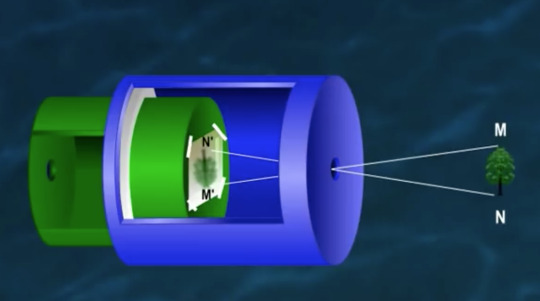
The clarity and sharpness of the image will differ depending on the size of the pinhole. The smaller the hole, the sharper the image. The larger the hole, the more blurry the image. The inventor of the camera obscura (precursor to the pinhole camera) was an Arab scholar named Ibn al-Haytham, also known as Alhazen, pictured below. He was born 945BC, died 1040BC. He was given credit and the label of the inventor but there have been references to the camera obscura in Chinese texts dating back to 400BC and also in the writings of Aristotle around 330BC.

This is especially interesting to me because that's how far back the fundamentals of photography arrived. We have the exposure triangle diagram to help us see the effects the elements of lighting has on each other, pictured below.

Aperture is what controls the light and depth of field. Depth of field is the distance around the focus that is sharp, not the object that's in focus.
ISO is the light sensitivity. To get the image as sharp as possible the ISO needs to be extremely low. If it is set too high there will be a grainy effect on the photo which is called noise. Although this sounds like a negative thing the grainy effect can actually look great when pulled off correctly.
Shutter speed controls light and motion and is measured in seconds. The more seconds that the shutter is open for the more light the lens is exposed to creating a higher exposure. The less seconds the shutter is open for the less light is allowed in and the lower the exposure. Too little light can result in the image being underexposed and too much light will overexpose it.
To conclude my findings I will place below pictures of the pinhole camera that my classmate Amy and I had made a week ago.
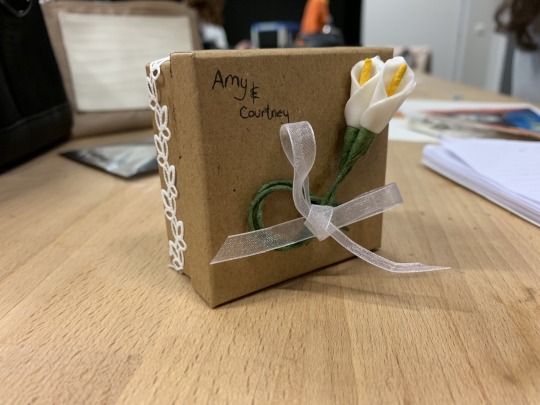
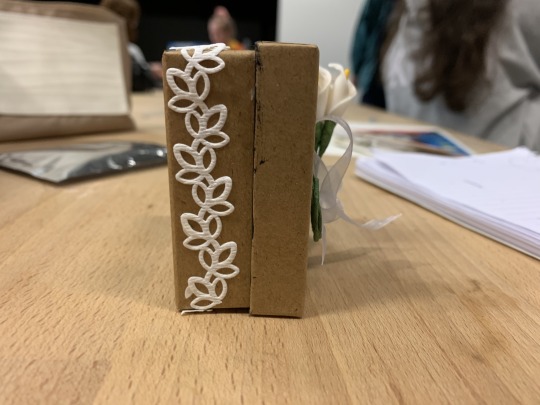
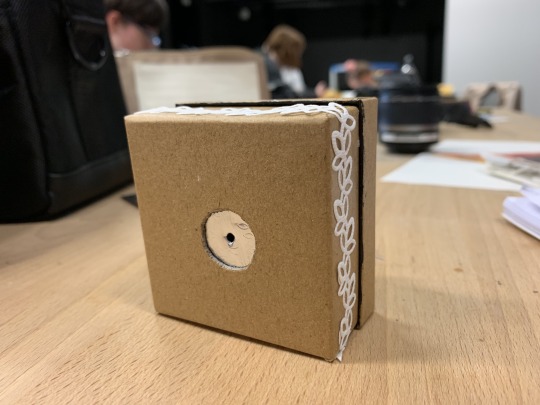
sources:
youtube.com - https://youtu.be/cWr2jrBwLsY
thoughtco.com - https://www.thoughtco.com/history-of-photography-and-the-camera-1992331
androidauthority.com - https://www.androidauthority.com/iso-setting-camera-photography-1017069/
0 notes
Text
What is Photography ?
Photography is the science, art, application and practice of creating durable images by recording light or other electromagnetic radiation, either electronically by means of an image sensor, or chemically by means of a light-sensitive material such as photographic film.
Typically, a lens is used to focus the light reflected or emitted from objects into a real image on the light-sensitive surface inside a camera during a timed exposure. With an electronic image sensor, this produces an electrical charge at each pixel, which is electronically processed and stored in a digital image file for subsequent display or processing. The result with photographic emulsion is an invisible latent image, which is later chemically "developed" into a visible image, either negative or positive depending on the purpose of the photographic material and the method of processing. A negative image on film is traditionally used to photographically create a positive image on a paper base, known as a print, either by using an enlarger or by contact printing.
Photography is employed in many fields of science, manufacturing (e.g., photolithography), and business, as well as its more direct uses for art, film and video production, recreational purposes, hobby, and mass communication.
Etymology
The word "photography" was created from the Greek roots φωτός (phōtos), genitive of φῶς (phōs), "light" and γραφή (graphé) "representation by means of lines" or "drawing", together meaning "drawing with light".
Several people may have coined the same new term from these roots independently. Hercules Florence, a French painter and inventor living in Campinas, Brazil, used the French form of the word, photographie, in private notes which a Brazilian historian believes were written in 1834. Johann von Maedler, a Berlin astronomer, is credited in a 1932 German history of photography as having used it in an article published on 25 February 1839 in the German newspaper Vossische Zeitung. Both of these claims are now widely reported but apparently neither has ever been independently confirmed as beyond reasonable doubt. Credit has traditionally been given to Sir John Herschel both for coining the word and for introducing it to the public. His uses of it in private correspondence prior to 25 February 1839 and at his Royal Society lecture on the subject in London on 14 March 1839 have long been amply documented and accepted as settled facts.
History
Main article: History of photography
See also: History of the camera
Precursor technologies
Photography is the result of combining several technical discoveries. Long before the first photographs were made, ancient Han Chinesephilosopher Mo Di from the Mohist School of Logic was the first to discover and develop the scientific principles of optics, camera obscura, and pinhole camera. Later Greek mathematicians Aristotle and Euclid also independently described a pinhole camera in the 5th and 4th centuries BCE. In the 6th century CE, Byzantine mathematician Anthemius of Tralles used a type of camera obscura in his experiments. Both the Han Chinese polymath Shen Kuo (1031–95) and Arab physicist Ibn al-Haytham (Alhazen) (965–1040) independently invented the camera obscura and pinhole camera, Albertus Magnus (1193–1280) discovered silver nitrate,and Georg Fabricius (1516–71) discovered silver chloride. Shen Kuo explains the science of camera obscura and optical physics in his scientific work Dream Pool Essays while the techniques described in Ibn al-Haytham's Book of Optics are capable of producing primitive photographs using medieval materials.
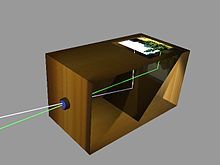
A camera obscura used for drawing
Daniele Barbaro described a diaphragm in 1566. Wilhelm Homberg described how light darkened some chemicals (photochemical effect) in 1694. The fiction book Giphantie, published in 1760, by French author Tiphaigne de la Roche, described what can be interpreted as photography.
The discovery of the camera obscura that provides an image of a scene dates back to ancient China. Leonardo da Vinci mentions natural camera obscura that are formed by dark caves on the edge of a sunlit valley. A hole in the cave wall will act as a pinhole camera and project a laterally reversed, upside down image on a piece of paper. So the birth of photography was primarily concerned with inventing means to capture and keep the image produced by the camera obscura.
Renaissance painters used the camera obscura which, in fact, gives the optical rendering in color that dominates Western Art. The camera obscura literally means "dark chamber" in Latin. It is a box with a hole in it which allows light to go through and create an image onto the piece of paper.
Invention of photography
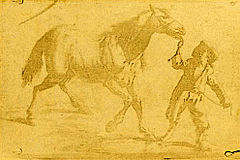
Earliest known surviving heliographic engraving, 1825, printed from a metal plate made by Nicéphore Niépce. The plate was exposed under an ordinary engraving and copied it by photographic means. This was a step towards the first permanent photograph taken with a camera.
Around the year 1800, British inventor Thomas Wedgwood made the first known attempt to capture the image in a camera obscura by means of a light-sensitive substance. He used paper or white leather treated with silver nitrate. Although he succeeded in capturing the shadows of objects placed on the surface in direct sunlight, and even made shadow copies of paintings on glass, it was reported in 1802 that "the images formed by means of a camera obscura have been found too faint to produce, in any moderate time, an effect upon the nitrate of silver." The shadow images eventually darkened all over.
The first permanent photoetching was an image produced in 1822 by the French inventor Nicéphore Niépce, but it was destroyed in a later attempt to make prints from it. Niépce was successful again in 1825. In 1826 or 1827, he made the View from the Window at Le Gras, the earliest surviving photograph from nature (i.e., of the image of a real-world scene, as formed in a camera obscura by a lens).
Because Niépce's camera photographs required an extremely long exposure (at least eight hours and probably several days), he sought to greatly improve his bitumen process or replace it with one that was more practical. In partnership with Louis Daguerre, he worked out post-exposure processing methods that produced visually superior results and replaced the bitumen with a more light-sensitive resin, but hours of exposure in the camera were still required. With an eye to eventual commercial exploitation, the partners opted for total secrecy.
Niépce died in 1833 and Daguerre then redirected the experiments toward the light-sensitive silver halides, which Niépce had abandoned many years earlier because of his inability to make the images he captured with them light-fast and permanent. Daguerre's efforts culminated in what would later be named the daguerreotype process. The essential elements—a silver-plated surface sensitized by iodine vapor, developed by mercury vapor, and "fixed" with hot saturated salt water—were in place in 1837. The required exposure time was measured in minutes instead of hours. Daguerre took the earliest confirmed photograph of a person in 1838 while capturing a view of a Paris street: unlike the other pedestrian and horse-drawn traffic on the busy boulevard, which appears deserted, one man having his boots polished stood sufficiently still throughout the several-minutes-long exposure to be visible. The existence of Daguerre's process was publicly announced, without details, on 7 January 1839. The news created an international sensation. France soon agreed to pay Daguerre a pension in exchange for the right to present his invention to the world as the gift of France, which occurred when complete working instructions were unveiled on 19 August 1839. In that same year, American photographer Robert Cornelius is credited with taking the earliest surviving photographic self-portrait.
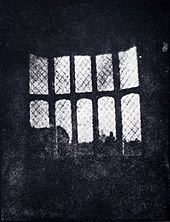
A latticed window in Lacock Abbey, England, photographed by William Fox Talbot in 1835. Shown here in positive form, this may be the oldest extant photographic negative made in a camera.
In Brazil, Hercules Florence had apparently started working out a silver-salt-based paper process in 1832, later naming it Photographie.
Meanwhile, a British inventor, William Fox Talbot, had succeeded in making crude but reasonably light-fast silver images on paper as early as 1834 but had kept his work secret. After reading about Daguerre's invention in January 1839, Talbot published his hitherto secret method and set about improving on it. At first, like other pre-daguerreotype processes, Talbot's paper-based photography typically required hours-long exposures in the camera, but in 1840 he created the calotype process, which used the chemical development of a latent image to greatly reduce the exposure needed and compete with the daguerreotype. In both its original and calotype forms, Talbot's process, unlike Daguerre's, created a translucent negativewhich could be used to print multiple positive copies; this is the basis of most modern chemical photography up to the present day, as Daguerreotypes could only be replicated by rephotographing them with a camera. Talbot's famous tiny paper negative of the Oriel window in Lacock Abbey, one of a number of camera photographs he made in the summer of 1835, may be the oldest camera negative in existence.
British chemist John Herschel made many contributions to the new field. He invented the cyanotype process, later familiar as the "blueprint". He was the first to use the terms "photography", "negative" and "positive". He had discovered in 1819 that sodium thiosulphate was a solvent of silver halides, and in 1839 he informed Talbot (and, indirectly, Daguerre) that it could be used to "fix" silver-halide-based photographs and make them completely light-fast. He made the first glass negative in late 1839.
In the March 1851 issue of The Chemist, Frederick Scott Archer published his wet plate collodion process. It became the most widely used photographic medium until the gelatin dry plate, introduced in the 1870s, eventually replaced it. There are three subsets to the collodion process; the Ambrotype (a positive image on glass), the Ferrotype or Tintype (a positive image on metal) and the glass negative, which was used to make positive prints on albumen or salted paper.
Many advances in photographic glass plates and printing were made during the rest of the 19th century. In 1891, Gabriel Lippmann introduced a process for making natural-color photographs based on the optical phenomenon of the interference of light waves. His scientifically elegant and important but ultimately impractical invention earned him the Nobel Prize in Physics in 1908.
Glass plates were the medium for most original camera photography from the late 1850s until the general introduction of flexible plastic films during the 1890s. Although the convenience of the film greatly popularized amateur photography, early films were somewhat more expensive and of markedly lower optical quality than their glass plate equivalents, and until the late 1910s they were not available in the large formats preferred by most professional photographers, so the new medium did not immediately or completely replace the old. Because of the superior dimensional stability of glass, the use of plates for some scientific applications, such as astrophotography, continued into the 1990s, and in the niche field of laser holography, it has persisted into the 2010s.
1 note
·
View note
Text
Photography History 1 via /#bestofcanvas
Photography History 1
Photography History 1 is the art, application, and practice of creating durable images by recording light or other electromagnetic radiation, either electronically by means of an image sensor, or chemically by means of a light-sensitive material such as photographic film.is the art, application, and practice of creating durable images by recording light or other electromagnetic radiation, either electronically by means of an image sensor, or chemically by means of a light-sensitive material such as photographic film. It is employed in many fields of science, manufacturing (e.g., photolithography), and business, as well as its more direct uses for art, film and video production, recreational purposes, hobby, and mass communication.
Photography History 1 a lens is used to focus the light reflected or emitted from objects into a real image on the light-sensitive surface inside a camera during a timed exposure. With an electronic image sensor, this produces an electrical charge at each pixel, which is electronically processed and stored in a digital image file for subsequent display or processing. The result with photographic emulsion is an invisible latent image, which is later chemically “developed” into a visible image, either negative or positive depending on the purpose of the photographic material and the method of processing. A negative image on film is traditionally used to photographically create a positive image on a paper base, known as a print, either by using an enlarger or by contact printing.
Etymology
The word “Photography History 1” was created from the Greek roots φωτός (phōtos), genitive of φῶς (phōs), “light”and γραφή (graphé) “representation by means of lines” or “drawing”,together meaning “drawing with light”
Several people may have coined the same new term from these roots independently. Hercules Florence, a French painter and inventor living in Campinas, Brazil, used the French form of the word, photographie, in private notes which a Brazilian historian believes were written in 1834.This claim is widely reported but is not yet largely recognized internationally. The first use of the word by the Franco-Brazilian inventor became widely known after the research of Boris Kossoy in 1980.
The German newspaper Vossische Zeitung of 25 February 1839 contained an article entitled Photographie, discussing several priority claims – especially Henry Fox Talbot’s – regarding Daguerre’s claim of invention.The article is the earliest known occurrence of the word in public print.It was signed “J.M.”, believed to have been Berlin astronomer Johann von Maedler. The astronomer Sir John Herschel is also credited with coining the word, independent of Talbot, in 1839.
The inventors Nicéphore Niépce, Henry Fox Talbot and Louis Daguerre seem not to have known or used the word “photography”, but referred to their processes as “Heliography” (Niépce), “Photogenic Drawing”/”Talbotype”/”Calotype” (Talbot) and “Daguerreotype” (Daguerre).
Precursor Technologies
Photography History 1 is the result of combining several technical discoveries, relating to seeing an image and capturing the image. The discovery of the camera obscura (“dark chamber” in Latin) that provides an image of a scene dates back to ancient China. Greek mathematicians Aristotle and Euclid independently described a camera obscura in the 5th and 4th centuries BCE In the 6th century CE, Byzantine mathematician Anthemius of Tralles used a type of camera obscura in his experiments
The Arab physicist Ibn al-Haytham (Alhazen) (965–1040) also invented a camera obscura as well as the first true pinhole camera. The invention of the camera has been traced back to the work of Ibn al-Haytham. While the effects of a single light passing through a pinhole had been described earlier,Ibn al-Haytham gave the first correct analysis of the camera obscura, including the first geometrical and quantitative descriptions of the phenomenon,and was the first to use a screen in a dark room so that an image from one side of a hole in the surface could be projected onto a screen on the other side. He also first understood the relationship between the focal point and the pinhole and performed early experiments with afterimages, laying the foundations for the invention of photography in the 19th century.
Leonardo da Vinci mentions natural camera obscura that are formed by dark caves on the edge of a sunlit valley. A hole in the cave wall will act as a pinhole camera and project a laterally reversed, upside down image on a piece of paper. Renaissance painters used the camera obscura which, in fact, gives the optical rendering in color that dominates Western Art. It is a box with a hole in it which allows light to go through and create an image onto the piece of paper.
The birth of photography was then concerned with inventing means to capture and keep the image produced by the camera obscura. Albertus Magnus (1193–1280) discovered silver nitrate and Georg Fabricius (1516–1571) discovered silver chloride, and the techniques described in Ibn al-Haytham’s Book of Optics are capable of producing primitive photographs using medieval materials.
Daniele Barbaro described a diaphragm in 1566. Wilhelm Homberg described how light darkened some chemicals (photochemical effect) in 1694.The fiction book Giphantie, published in 1760, by French author Tiphaigne de la Roche, described what can be interpreted as photography.
Around the year 1800, British inventor Thomas Wedgwood made the first known attempt to capture the image in a camera obscura by means of a light-sensitive substance. He used paper or white leather treated with silver nitrate. Although he succeeded in capturing the shadows of objects placed on the surface in direct sunlight, and even made shadow copies of paintings on glass, it was reported in 1802 that “the images formed by means of a camera obscura have been found too faint to produce, in any moderate time, an effect upon the nitrate of silver.” The shadow images eventually darkened all over.
Invention
The first permanent photoetching was an image produced in 1822 by the French inventor Nicéphore Niépce, but it was destroyed in a later attempt to make prints from it.Niépce was successful again in 1825. In 1826 or 1827, he made the View from the Window at Le Gras, the earliest surviving photograph from nature (i.e., of the image of a real-world scene, as formed in a camera obscura by a lens).
View from the Window at Le Gras, 1826 or 1827, the earliest surviving camera photograph
Because Niépce’s camera photographs required an extremely long exposure (at least eight hours and probably several days), he sought to greatly improve his bitumen process or replace it with one that was more practical. In partnership with Louis Daguerre, he worked out post-exposure processing methods that produced visually superior results and replaced the bitumen with a more light-sensitive resin, but hours of exposure in the camera were still required. With an eye to eventual commercial exploitation, the partners opted for total secrecy.
Niépce died in 1833 and Daguerre then redirected the experiments toward the light-sensitive silver halides, which Niépce had abandoned many years earlier because of his inability to make the images he captured with them light-fast and permanent. Daguerre’s efforts culminated in what would later be named the daguerreotype process. The essential elements—a silver-plated surface sensitized by iodine vapor, developed by mercury vapor, and “fixed” with hot saturated salt water—were in place in 1837. The required exposure time was measured in minutes instead of hours. Daguerre took the earliest confirmed photograph of a person in 1838 while capturing a view of a Paris street: unlike the other pedestrian and horse-drawn traffic on the busy boulevard, which appears deserted, one man having his boots polished stood sufficiently still throughout the several-minutes-long exposure to be visible. The existence of Daguerre’s process was publicly announced, without details, on 7 January 1839. The news created an international sensation. France soon agreed to pay Daguerre a pension in exchange for the right to present his invention to the world as the gift of France, which occurred when complete working instructions were unveiled on 19 August 1839. In that same year, American photographer Robert Cornelius is credited with taking the earliest surviving photographic self-portrait.
A latticed window in Lacock Abbey, England, photographed by William Fox Talbot in 1835. Shown here in positive form, this may be the oldest extant photographic negative made in a camera.
In Brazil, Hercules Florence had apparently started working out a silver-salt-based paper process in 1832, later naming it Photographie.
Meanwhile, a British inventor, William Fox Talbot, had succeeded in making crude but reasonably light-fast silver images on paper as early as 1834 but had kept his work secret. After reading about Daguerre’s invention in January 1839, Talbot published his hitherto secret method and set about improving on it. At first, like other pre-daguerreotype processes, Talbot’s paper-based photography typically required hours-long exposures in the camera, but in 1840 he created the calotype process, which used the chemical development of a latent image to greatly reduce the exposure needed and compete with the daguerreotype. In both its original and calotype forms, Talbot’s process, unlike Daguerre’s, created a translucent negative which could be used to print multiple positive copies; this is the basis of most modern chemical photography up to the present day, as daguerreotypes could only be replicated by rephotographing them with a camera.Talbot’s famous tiny paper negative of the Oriel window in Lacock Abbey, one of a number of camera photographs he made in the summer of 1835, may be the oldest camera negative in existence.
In France, Hippolyte Bayard invented his own process for producing direct positive paper prints and claimed to have invented photography earlier than Daguerre or Talbot.
British chemist John Herschel made many contributions to the new field. He invented the cyanotype process, later familiar as the “blueprint”. He was the first to use the terms “photography”, “negative” and “positive”. He had discovered in 1819 that sodium thiosulphate was a solvent of silver halides, and in 1839 he informed Talbot (and, indirectly, Daguerre) that it could be used to “fix” silver-halide-based photographs and make them completely light-fast. He made the first glass negative in late 1839.
In the March 1851 issue of The Chemist, Frederick Scott Archer published his wet plate collodion process. It became the most widely used photographic medium until the gelatin dry plate, introduced in the 1870s, eventually replaced it. There are three subsets to the collodion process; the Ambrotype (a positive image on glass), the Ferrotype or Tintype (a positive image on metal) and the glass negative, which was used to make positive prints on albumen or salted paper.
Many advances in photographic glass plates and printing were made during the rest of the 19th century. In 1891, Gabriel Lippmann introduced a process for making natural-color photographs based on the optical phenomenon of the interference of light waves. His scientifically elegant and important but ultimately impractical invention earned him the Nobel Prize in Physics in 1908.
Glass plates were the medium for most original camera photography from the late 1850s until the general introduction of flexible plastic films during the 1890s. Although the convenience of the film greatly popularized amateur photography, early films were somewhat more expensive and of markedly lower optical quality than their glass plate equivalents, and until the late 1910s they were not available in the large formats preferred by most professional photographers, so the new medium did not immediately or completely replace the old. Because of the superior dimensional stability of glass, the use of plates for some scientific applications, such as astrophotography, continued into the 1990s, and in the niche field of laser holography, it has persisted into the 2010s.
Source
Submitted November 29, 2019 at 04:58PM
via #bestofcanvas https://www.reddit.com/r/u_HoustonCanvas/comments/e3mlvm/photography_history_1/?utm_source=ifttt
0 notes
Text
went to the coolest exhibition for work that i never would have gone to on my own but the design was awesome and I'm obsessed. it was 3 rooms and I could've stayed in there for another hour. those are folded NAPKINS. hello!!
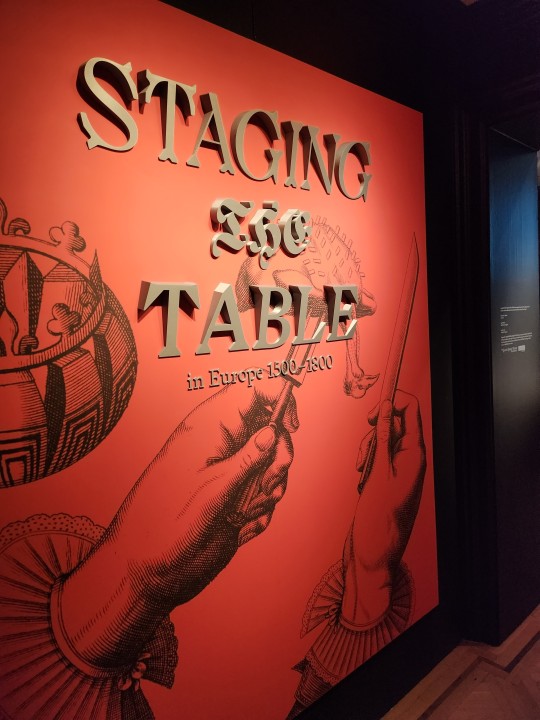

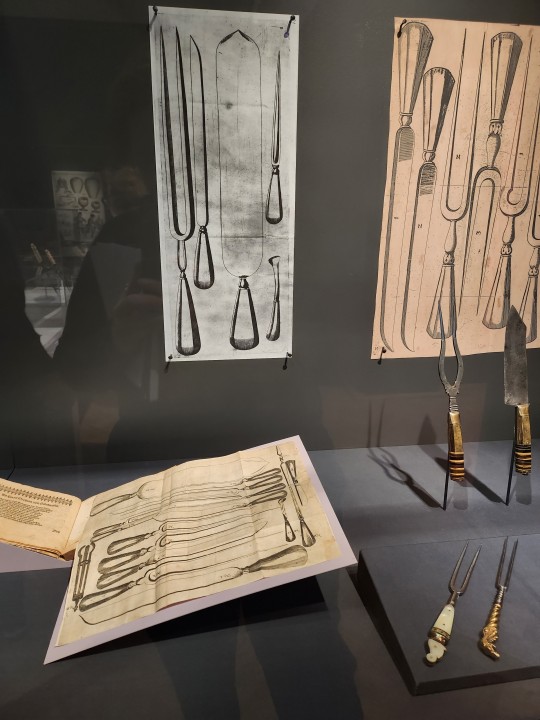
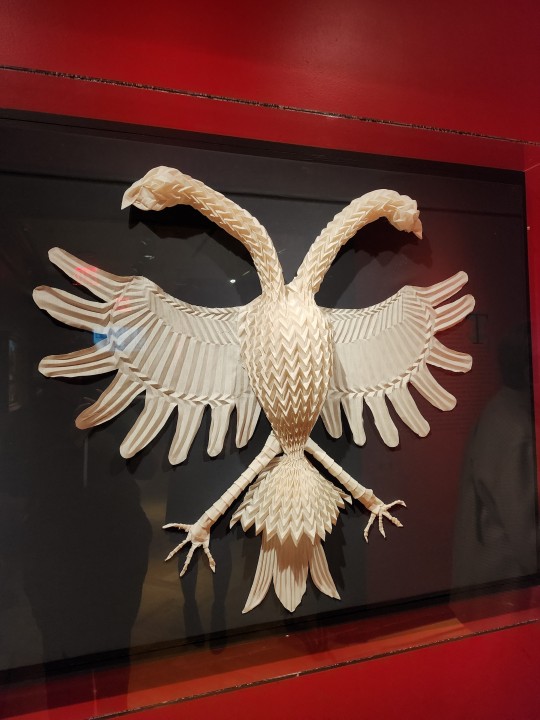
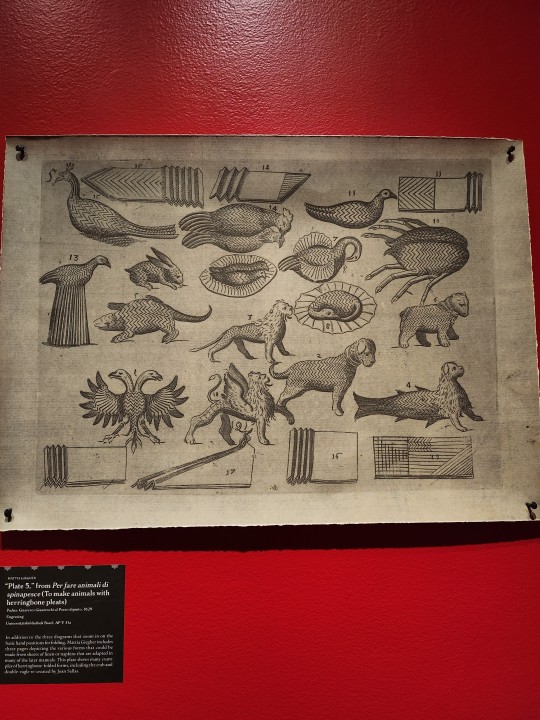
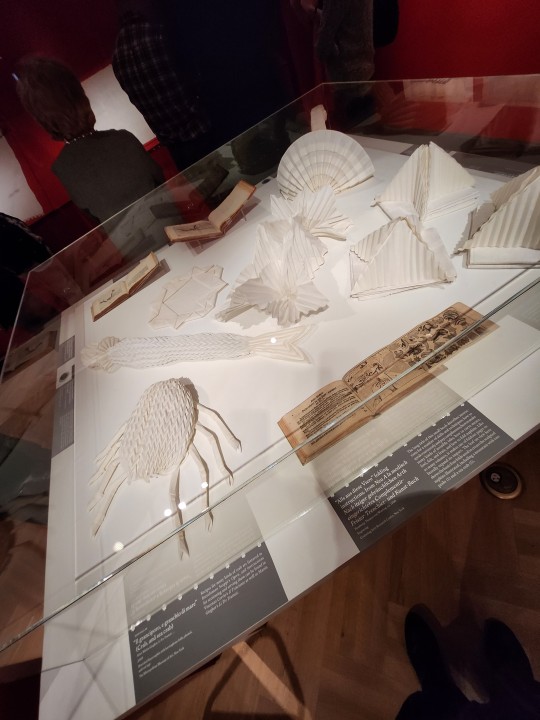

#the last one is a book abt a magic lantern#like a precursor to film and the camera obscura#and its the skeletons doing motions for 'tricks' to perform for the dining guests#who knew that dining could be so wacky??#there was also a video of a guy folding all these napkin animals that i wish i could watch for 17 hrs straight#at the Bard Graduate Center Gallery#also the way i cackled at 'officers of the mouth'#oh???? what that mouth do??
0 notes